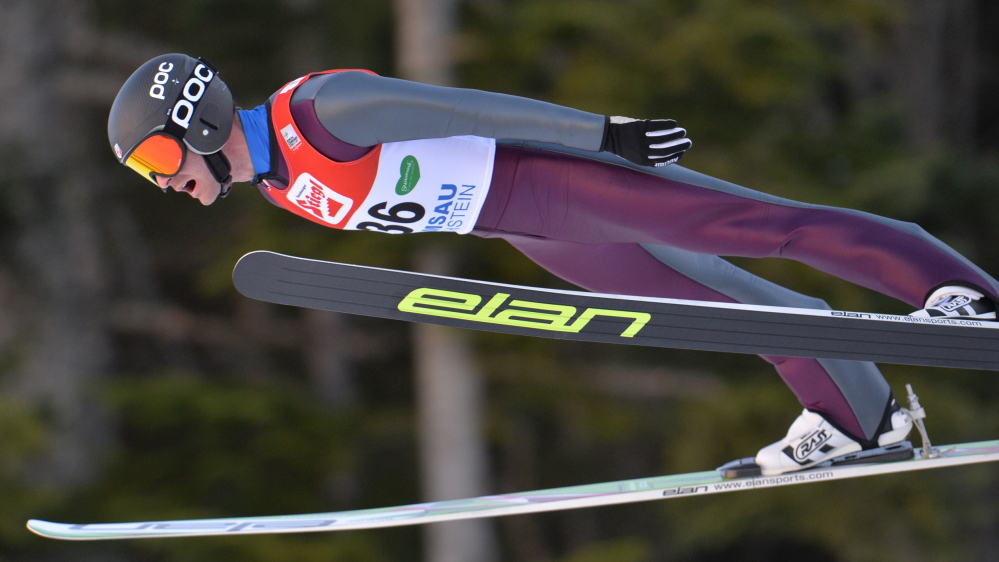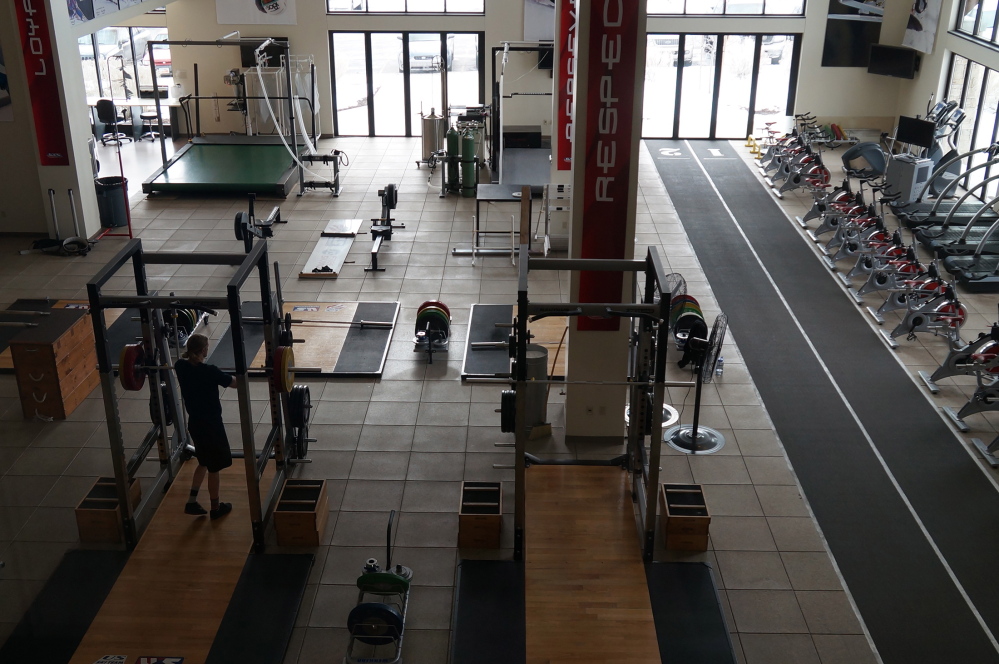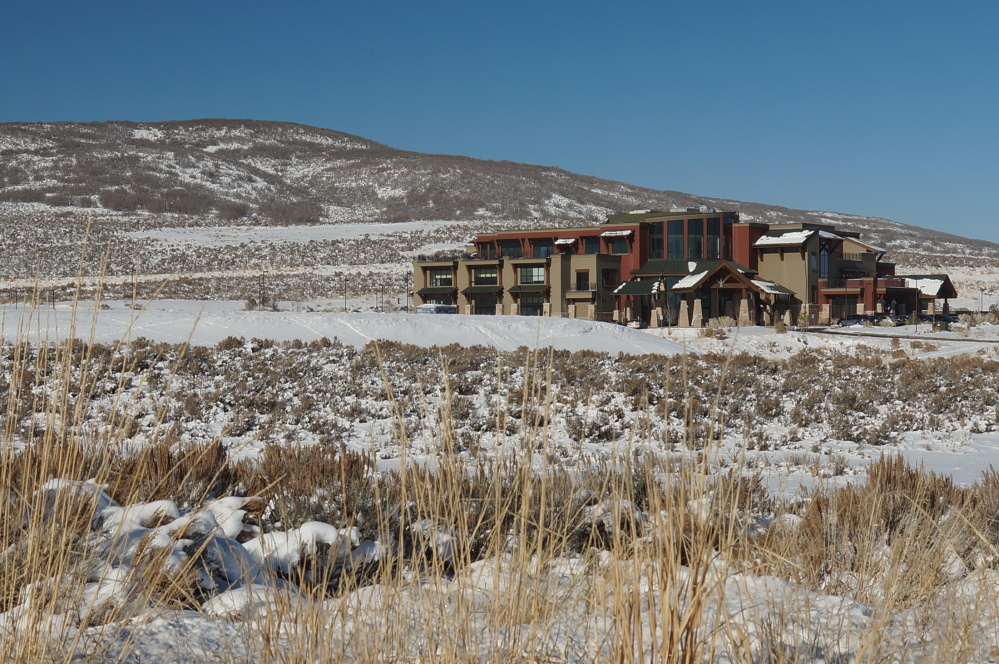PARK CITY, Utah — Russia’s Caucasus Mountains are more than 6,000 miles from Park City, Utah. But the undulating course on which the Nordic combined will be contested at the 2014 Sochi Olympics unfolds on the video screen here in front of Bryan Fletcher, who roller-skis at a carefully calibrated pace (8.3 miles per hour, at a 2.08 degree elevation, to be exact) on a treadmill wide enough for a Chevy Suburban.
Tethered to a vacuum tube that covers his nose and mouth, Fletcher inhales air with the precise concentration of oxygen found at elevation on the Olympic course and expels air that’ s captured by a separate container for further analysis. The setup looks like a mad scientist’s experiment, with Fletcher serving as a 5-feet-9, 145-pound lab rat clad in skin-tight ski gear and the sunglasses he’ll wear in competition. It’s the brainchild of Jim Stray-Gundersen, a former competitive cross-country skier, surgeon and sports science adviser to the U.S. Ski team, who explained the methodology during a recent tour of the U.S. Ski and Snowboard Association’s Center of Excellence in Park City, Utah.
“It’s a game-change for our teams,” Stray-Gundersen says of the purpose-built treadmill, designed to measure and maximize the efficiency with which athletes use oxygen and, as a result, make inroads in the historically European-dominated sport that marries ski jumping with cross-country racing.
But he could just as easily be speaking of the center itself. With neither mountains to rival the European Alps nor a centuries’ old Nordic skiing tradition, the U.S. Ski and Snowboard Association has compensated with this $25 million Center of Excellence, the result of American ingenuity and private philanthropy. The technology treadmill is just one piece of equipment in the three-story complex, which since its May 2009 opening has emerged as a major asset in the United States’ pursuit of Winter Olympics hegemony.
If the Center of Excellence is akin to an athletic factory, its goal is the opposite of mass production, providing training, physical therapy, coaching and nutrition services that are tailored to the specific demands of each winter sport and each athlete vying for a share of Olympic glory.
The building makes a lavish first impression, with its modern architecture, sun-drenched open spaces and state of-the-art equipment. But in the context of outsize Olympic spending — Russia’s tab for hosting the Sochi Games reportedly tops $48 billion — it has proven a shrewd investment.
The United States topped the medal tables at the 2010 Vancouver Games, where American skiers and snowboarders accounted for 21 of its 37 medals. With the majority of Sochi-bound athletes taking advantage of the center’s resources over the past Olympic cycle, the complex likely will play a major role in the U.S. fortunes in Sochi, where 49 of 98 Olympic events will be contested by skiers and snowboarders.
With less than two months before Sochi’s Feb. 7 opening ceremonies, the center is as silent as a city street awakening from a blizzard. Most prospective Olympians are off competing throughout Europe and North America to solidify their places on the Sochi-bound team. But in the off-season, it’s a star-studded hive of activity.
The lobby sets the tone: It’s a building designed to honor the past, yet dedicated to shattering its limits.
As skier Andrew Weibrecht, who won bronze in the super G in Vancouver, put it in a phrase that’s emblazoned on a prominent display: “Gravity: It’s more of a nuisance than a law.”
The lobby spills into a two-story weight room adorned with oversized photos of champions such as skiers Billy Kidd and Lindsey Vonn and snowboarding pioneers Danny Kass and Hannah Kearney.
There are weight stations for every body type and muscle group. The technology treadmill is at one end, where Fletcher, a Steamboat Springs, Colo., native who relocated to Park City to train, is exercising away. At 27, he’s enjoying the best results of his career this season, earning four top-10 finishes on the World Cup circuit while helping the U.S. claim its first team medal (a bronze) in Nordic combined at the World Ski Champions in Italy.
If Nordic combined is among the oldest Winter Olympic sports, snowboarding and free skiing are the Games’ revolutionary disciplines, celebrating athletes who invent new tricks without regard to convention or common sense. The center houses a gym dedicated to that, too.
Here in a space nicknamed “Ramps and Tramps” is a Willy Wonka-styled playpen for gravity-defying daredevils. The centerpiece is a trampoline known as a Supertramp: twice the size of a standard one with over-sized springs that enable aerialists to practice high-risk flips and twists without exacting the pounding of hard-packed snow.
Three-time U.S. champion Dylan Ferguson, a freestyle aerialist, and Devin Logan, a free skier whose specialty is halfpipe and slopestyle, joyfully demonstrate, bouncing and flipping at impossible heights and landing in a giant pit chocked with cubes of blue foam. They don’t make a sound when they plunge into the foam; it’s as if they’re jumping into a two-story feather pillow.
In addition to being gentle on the joints, the Supertramp is also an efficient workout, U.S. aerials coach Joe Davies explains, because the athletes don’t waste time riding a ski lift between jumps. And each workout is filmed with high-definition technology, providing instant feedback on body positioning and amplitude.
“It also helps us work on our muscle memory,” Logan explains. “And we can attempt new tricks before taking them onto the snow. The Supertramp really helps with that.”
As far as Davies knows, no other country’s athletes have a Supertramp.
From the gym, it’s just a short walk to the center’s performance nutrition test-kitchen, where USSA dietician Allen Tran has just whipped up a batch of pumpkin smoothies made with Greek yogurt, soy milk and a clever mélange of spices.
Tran and the staff of nutritionists not only prepare meals and snacks for athletes who train here but also design diet plans based on the volume and intensity of their training any given week, spelling out the precise amount of whole grains, lean protein, vegetables and fruits, fats and flavors accordingly. They offer handouts illustrating the optimum-size servings of each for an easy training day, a moderate day, as well as a competition day. And the plans cover the full range of nutritional demands, suiting ski jumpers who might need 1,600 calories per day as well as downhill skiers who might gobble 6,000 calories a day.
Given that nearly every world-class athlete owns a blender, Tran offers two pages of smoothie recipes broken down into six categories – veggie, fruit, weight-gain, low-calorie, recovery and sweet tooth – demonstrating the endless possibilities of spinach and celery, bananas and frozen blueberries, peanut butter and avocado, cucumber and cooked beets, protein powder and flaxseed.
“It has been a huge resource for all the athletes,” says two-time Olympic skier Travis Ganong, 25, who lives in Squaw Valley, Calif., but travels to the center for specialized workouts, and meals, every third week. “We have all become more professional because of it and more dedicated.”
– – –
Skiing and snowboarding for the U.S. Olympic team is not just about taking to the slopes. At the Center of Excellence, Washington Post Lee Powell videographer found it involves science, whirlpools and nutrition. The Fold: All in one center gives Winter Olympians edge
bc-oly-nordic (TPN)
Send questions/comments to the editors.





Success. Please wait for the page to reload. If the page does not reload within 5 seconds, please refresh the page.
Enter your email and password to access comments.
Hi, to comment on stories you must . This profile is in addition to your subscription and website login.
Already have a commenting profile? .
Invalid username/password.
Please check your email to confirm and complete your registration.
Only subscribers are eligible to post comments. Please subscribe or login first for digital access. Here’s why.
Use the form below to reset your password. When you've submitted your account email, we will send an email with a reset code.